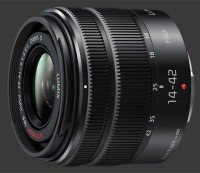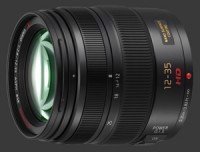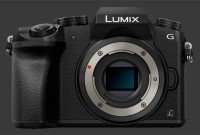Panasonic Lumix DMC-G7 Review
Panasonic Lumix DMC-G7 Performance - How well does it take pictures?
Performance starts with image quality, which is the criteria used as the foundation of our digital camera ratings. Ergonomic issues may get in the way, but in the end, image quality counts the most. For an ILC, image quality greatly depends on the lens used. While color, noise, exposure and dynamic-range are properties of a camera, distortion, vignetting and chromatic aberrations are properties of the lens. Sharpness and contrast depend on the weakest link. That is, a camera cannot capture more details than a lens lets through. Conversely, it is quite possible for a lens to transmit more details than a sensor can capture.

Image Noise & Details
Image quality from the Panasonic Lumix DMC-G7 is good. The native ISO 200 sensitivity is essentially noise-free, as are other sensitivities up to ISO 800 which barely shows speckles in luminance which have almost no impact on the finest details. This makes it easily possible to produce sharp 16" x 12" print and even slightly larger ones.
The Venus engine offers 11 levels of noise-reduction which affects the performance of higher sensitivities. Its default is somewhat aggressive with optimal output when it is set to -3. At that setting, visible noise increases steadily while maximizing detail retention. ISO 1600 and 3200 both produce impressive mid-sized prints, easily up to 12" x 9".
ISO 6400 is notably noisier which destroys fine details. Noise-reduction is gentle enough that it preserves a good amount of details and removes any chroma-noise. Mid-size prints may be acceptable for brighter subjects and small prints remain perfectly usable. ISO 12800 has even more noise and fewer details. It can make usable small prints but that is it.
The maximum ISO of 25600 is really noisy. One can still recognise a subject and make small images for web use. At the opposite end of the spectrum, the expanded Low ISO of 100 is noise-free yet distorts color and noticeably clips dynamic-range.
Sharpness on the G7 is adjustable in 11 steps, like most other image-parameters. The default is slightly soft. Raising it to +2 improves things considerably while introducing only minor sharpening artifacts. Higher levels show clear halos which makes images look like paper cut-outs.

Color & White Balance
Color accuracy could be improved. Both Standard nor Natural photo-styles show shifts in color, with the red channel appearing more sensitive than it should be. Reality falls somewhere in between these two styles. Starting at Natural and reducing Saturation to -1 improves colors which then requires a +1 boost of Contrast for images not to look dull.
Automatic While-Balance performs somewhat below average. It balances colors well under natural light but often leaves a strong yellow cast under artificial lighting. This can be corrected using presets or Custom White-Balance which is quite accurate. One very welcome feature of the G7 is that the LCD can be adjusted in terms of Saturation and Tint along 2 axis. This makes it possible to calibrate the display so that it correctly previews white-balance and therefore allows white-balance fine-tuning to be used reliably. Be careful when changing sensitivity though because ISO 100 exaggerates the red channel even more.
Exposure
The multi-segment metering system of the Panasonic G7 is reasonable. It tends to produce bright images which forces highlights to be clipped more often than usual. For low-contrast scenes, there is no problem since this produces print-ready images right in the camera. Typical outdoor scenes though often show severely over-exposed areas due to the limited dynamic-range of the G7 which is unexpectedly below that of most mirrorless cameras. Again, ISO 100 compounds the problem by losing almost one stop of dynamic-range.
It is important to realize that the EVF and LCD are not Exposure-Priority, except optionally in Manual mode. They rarely preview exposure correctly, even for scenes that fall well within the metering range of the camera. There is an optional live-histogram which is not reliable either since it shows the luminance distribution of the display rather than the expected exposure. While there are 4 options for Monitor Luminance, none is reliable.

Auto Focus
This mirrorless digital camera has a very fast Contrast-Detect autofocus system. It locks focus quickly. Even in moderate light, it locks focus in ¼s. Under low illumination, it can take a little longer but rarely more than ½s. This new Contrast-Detect AF offers a class-leading sensitivity, down to -4 EV which exceeds the capability of nearly every other camera.
To speed things up, Panasonic provides two options: Quick-AF and Eye-Start AF. For the former, the G7 starts focusing as soon as the camera is held steadily, presumably because the photographer is getting ready to take a shot. The the latter, it starts when the Eye-Start Sensor gets triggered. When the shutter-release is pressed halfway, the G7 then only needs to adjust focus a little but this can also makes things jumpy when doing multiple shots that need to match for things like HDR or panoramas.
Speed
The Panasonic G7 is extremely responsive. This camera does not slow the photographer down, every button press and dial turn is immediately registered. Its performance is characterized by the following numbers:
- Power-On: Under 1s. Very good.
- Power-On to First-Shot: 1¼ seconds. Quite good.
- Autofocus: Under ½s normally, up to ¾s in low-light. Good.
- Shutter-lag: Instant with about ¼s blackout. Excellent.
- Shot-to-shot: ¾s with AF, just over 1/3s without. Superb.
- Playback: Instant to enter, ½s to exit. Good.
- Power-Off: 4s. Glacial.
- Video: Instant to start or stop, pause 1½s after to flush buffer. Very good.
This G7 delivers impressive numbers in nearly all areas, almost identical to the speed of the flagship GX8. Autofocus was measured to be slower which is most likely due to the Panasonic Lumix G Vario 14-42mm F/3.5-5.6 Mega OIS II
Panasonic Lumix G Vario 14-42mm F/3.5-5.6 Mega OIS II lens compared to the Panasonic Lumix G X Vario 12-35mm F/2.8 ASPH OIS
Panasonic Lumix G X Vario 12-35mm F/2.8 ASPH OIS used for the Panasonic GX8 review
Panasonic Lumix DMC-GX8. These cameras otherwise appear to use the same autofocus system with innovative Depth-From-Defocus (DFD) technology.
The lower resolution sensor uses less power than the 20 MP counter-part in the GX8. This gives the G7 a better battery-life of 350 shots-per-charge which is still below average for a mirrorless. Plan to keep at last an extra battery for a full day of shooting. The only inexplicably slow number is the time it takes to power off. The camera takes a short pause after filming which is not ideal but, at least, it starts filming immediately.
Panasonic Lumix DMC-G7 Conclusion

The Panasonic Lumix DMC-G7 is a prosumer mirrorless that offers a rich feature-set in a relatively light-weight body without compromising on ergonomics. Its dual control-dials, numerous buttons with many customization options and a large 0.5" protruding 2.4 megapixels EVF with Eye-Start sensor make it efficient and a pleasure to use. It sits just below the flagship GX8
Panasonic Lumix DMC-GX8 in the Panasonic mirrorless lineup only due to its lack of image-stabilization and weather-sealing.
Image quality is quite good. Image noise is well under control and details stay remarkably intact as ISO increases. Maximum size prints look great until ISO 800 while mid-sized ones are easy possible until ISO 3200. The new processing engine is faster than previous generations yet lags in terms of output quality. While sharpness and noise-reduction are very good with the right settings, colors and white-balance have room for improvement. This, of course, is entirely avoidable by those who shoot RAW.
The real issue with the G7 is that its metering tends towards over-exposure which happens quite often considering the sensor in this digital camera does not have as wide a dynamic-range as other recent mirrorless offerings. One could judiciously apply Exposure-Compensation to correct metering if only the EVF and LCD were Exposure-Priority which is only possible for Manual exposure.
The Panasonic G7 is impressively fast. With exception to slowness while powering-off, which is rather unimportant, the G7 is consistently fast. Shot-to-shot speed and black-out time are very impressive. The AF system is extremely sensitive, highly accurate and speedy.
Along with a complete set of advanced photography features, the G7 offers top-notch video capabilities. It is one of the lightest mirrorless to capture 4K Ultra-HD video which it does with a slightly reduced field-of-view to avoid under-sampling artifacts. It can also capture 1080p HD video at 60 FPS with full coverage. Video quality is excellent and the camera starts recording immediately from its dedicated Video mode.
The final word on the Panasonic G7 is that it is a highly capable camera with only one major flaw which is its multi-segment metering system. Still, this mirrorless is capable of producing some fantastic images with good sharpness, superb retention of details and low noise, all from within an efficient and ergonomically-designed camera body.
 |
Please Support Neocamera
All information on Neocamera is provided free of charge yet running this website is a huge endeavor. Purchases made via affiliate links found throughout the site help keep it running and up-to-date. There is no additional cost to you, so please consider buying via these links to our affilates:
If you found any information on this site valuable and did not purchase via our affiliate links, please considering donating via PayPal:
Any amount will be greatly appreaciated. Thank you for your support!
Panasonic DMC-G7 Highlights

Sensor-Size: 17 x 13mm

Actual size when viewed at 100 DPI
| 16 Megapixels Mirrorless | ISO 100-25600 |
| Micro Four-Thirds Mount 2X FLM | Shutter 1/16000-60s |
| 0.50" Built-in EVF 2.4 Megapixels (0.70X) | Full manual controls, including Manual Focus |
| Automatic Eye-Start sensor | Custom white-balance with 2 axis fine-tuning |
| 2 Axis Digital Level | Spot-Metering |
| Built-in Dust Reduction | Hot-Shoe |
| 8 FPS Drive, 100 Images | Stereo audio input |
| 3840x2160 @ 30 FPS Video Recording | Lithium-Ion Battery |
| 3" LCD 1 Megapixels | Secure Digital Extended Capacity |
Updates
2024.11.18

Best 2024 Photography Gifts for Every Budget
Great gifts for photographers and photo enthusiasts selected for every budget among the best products of 2024.
2024.08.07

Eye Protection Tips for Professional Photographers
The four main considerations for professional photographers regarding eyewear.
2024.07.14

Fujifilm X100VI Review
Flagship fixed-lens compact digital camera with a 40 MP sensor and Image-Stabilization, a first for the series. Retro design featuring dual control-dials, plus direct ISO, Shutter-Speed and EC dials. Its hybrid viewfinder can switch between EVF and OVF mode.
2024.05.09

Fujifilm GFX100 II Review
Flagship 102 Megapixels Medium-Format Mirrorless Digital Camera with 8-Stop 5-Axis IBIS, 8 FPS Drive, 8K Video and 400 MP Super-Resolution capture in a weatherproof and freezeproof body with dual control-dials and dual memory-card slots.
2024.04.03

Fujifilm X-T5 Review
Newest Fujifilm flagship boasting a 40 MP APS-C sensor, 5-axis IBIS with 7-stop efficiency, 15 FPS continuous drive, 6.2K Video capture, dual control-dials and dual SDXC UHS-II slots in a sturdy weatherproof and freezeproof body.
2023.11.20

Best Digital Cameras of 2023
Find out which are the Best Digital Cameras of 2023. All the new Mirrorless Digital Cameras from entry-level to high-end professional.
2023.07.10

Fujifilm X-H2 Review
40 Megapixels APS-C Hybrid Mirrorless Digital Camera with 7-stop IBIS. Fastest shutter ever and 8K video capture. Large builtin EVF with 0.8X magnification and 5.8 MP, plus an Eye-Start Sensor. Packed with features and large number of controls in a weatherproof and freezeproof body.
2023.05.07

Sony FE 20-70mm F/4G Review
Review of the unique Sony FE 20-70mm F/4G lens. The optical zoom of this lens spans ultra-wide-angle and medium focal-length coverage, making it one of the most versatile Full-Frame lenses on the market.
2023.01.15

Huion Inspiroy Dial 2 Review
Review of the Huion Inspiroy Dial 2 tablet, a medium sized drawing surface with dual dials and customizable buttons. Connects via USB-C or Bluetooth 5.0 with Windows, Linux and Android support.
2022.12.08

How to Pack for a Photo Trip
Find out how to pack for a travel photography trip, carry your gear safely while meeting airline regulations.
2022.11.13

Best Digital Cameras of 2022
The best digital cameras of 2022. A short list of the most outstanding models in their respective categories. Choose one for yourself or as a gift.
2022.09.21

Pentax DA* 60-250mm F/4 SDM Review
Review of the Pentax DA* 60-250mm F/4 SDM, the constant-aperture telephoto zoom with the highest zoom-ratio on the market.












